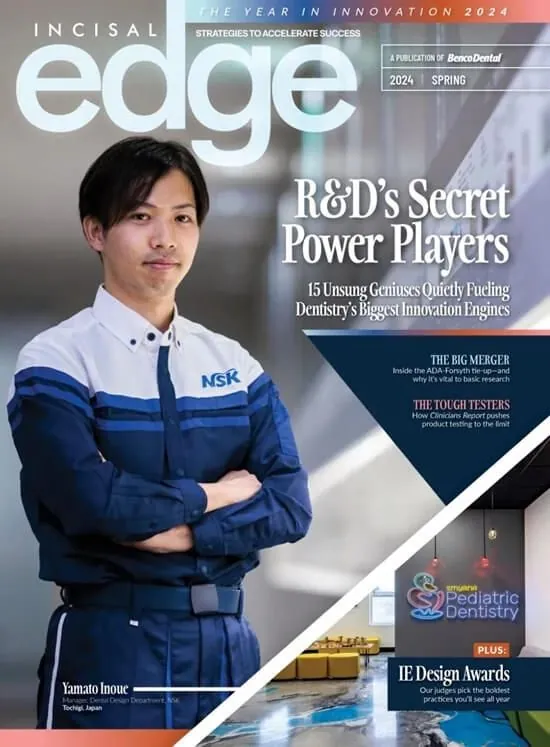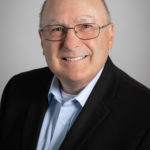Innovation is vital to the future of dentistry. Those who can manage the accompanying information tsunami are even more so.
THIS ISSUE, FOR THE third year running, Incisal Edge celebrates the nominees for the Edison Awards: the game-changing innovators whose products and ideas will shape the course of dentistry in the years ahead.
Part of what spurs such innovation is the fact that never before has humanity had greater, readier access to so much information. Having the entire world at our fingertips, though, has ushered in an attendant age of distraction. Think of yourself or your family at home, immersed in a “two-screen” experience: paying attention to a television, computer screen or tablet, as well as the ubiquitous smartphone. Our eyes bounce like ping-pong balls. Our minds do, too.
The digital generation gap, meanwhile, seems only to widen. I saw a TV commercial not long ago in which a mother and daughter are at a restaurant with the daughter’s new boyfriend. At meal’s end, the boyfriend’s attention is fixed on his phone. He’s trying to be surreptitious, but the mother scowls: Has her daughter ever picked a loser! Then, the transformative moment. The boyfriend looks up and displays his phone screen. He’s just paid the bill himself. It’s a useful reminder that in a mobile age, things aren’t always what they first appear to be.
In my primary job as a dental educator and researcher, I’m surrounded not only by students but also clinicians who teach and practitioners taking CE courses. It’s not unusual for dentists older than 50 to ask me, “What’s wrong with students today?” They’re out of touch, I’m told, and lack the social and interactive skills so vital to quality patient care.
The digital era offers dental clinicians great value. The challenge lies in knowing how to sort through and apply all that information. We must continue to use (and, crucially, to teach) critical-thinking skills.
These concerns are real. But there’s a positive side my interlocutors aren’t seeing: Not a day passes that I don’t witness students scanning YouTube and countless other sites for videos and articles that will help boost their technical skills. They have extraordinary access to a wealth of dental information, and they’re availing themselves of it.
All of us, though, need to be better about limiting the inherent distractions of the information age. This requires great discipline. E-mail is a particular personal
bugbear; some weeks I spend many hours just trying to dig myself out. I’m always looking outside dentistry for ways to understand and manage myself better, though, and one invaluable tool I recently came across is Alone Together, a 2011 book (printed on paper and everything!) by MIT sociologist Sherry Turkle.
Alone Together — the title gives the game away instantly — is a damning overview of how digital-era adults interact with one another. Turkle’s observations have helped me immeasurably as a dentist, an educator and, frankly, a human being. One small but representative example: I now generally respond to in-house e-mails of moderate complexity in person — a radical concept, I know — instead of beginning to unspool an endless, frustrating message thread.
One other aspect of the information age that bears examining: the (ahem) fact that even facts themselves have become horribly devalued. Technology podcaster Leo Laporte has observed that in the past, if you needed to know something, you opened a reference book or even headed to the library. Then, in the early 1990s, Microsoft introduced Encarta, a CD-ROM encyclopedia with content and graphics curated by a variety of experts. Today, the print encyclopedia has become obsolete, and online sources — even or perhaps especially Wikipedia — can’t always be trusted.
Facts, accordingly, are no longer as sacrosanct as they once were. To look up a piece of information used to require a modicum of critical thinking. Now, though, that’s being shunted aside in favor of artificial intelligence such as Apple’s Siri, Amazon’s Alexa and others still in development by people like the Edison innovators we honor in this issue. Data are supreme, knowledge is fleeting.
I don’t mean to be a downer, and I’m certainly no Luddite. The digital era offers dental clinicians great value. The challenge lies in knowing how to sort through and apply all that information. We must continue to use — and, crucially, to teach — critical-thinking skills.
Dentists everywhere need to be able to ask the hard questions when presented with new treatment ideas and dental concepts. Don’t just take someone’s word; understand the supporting evidence. The information age is like fire: Managed well, its utility is endless. Managed poorly, it can do incalculable harm. This year’s Edison Awards nominees know this. Be forever vigilant that you do too.
HOWARD STRASSLER, DMD is a professor and the director of operative dentistry at the University of Maryland School of Dentistry. He practices in Pikesville, Maryland.
Offbeat Cases, Extraordinary Solutions
PROBLEM SOLVING is in dentists’ very marrow — or should I say dentin. Our education provided us with an information framework that enables us to take everyday treatment techniques, materials and ideas, and have the confidence to make the mental leap to employ them in unforeseen clinical situations.
Unforeseen — or unprecedented. Every so often all dentists will encounter a situation they’ve never heard about, much less seen in person. It can be something as routine as a patient complaining of soreness after biting into a bagel. Your initial diagnosis: tooth mobility due to periodontal compromise. Except . . . the teeth have significant spacing, and normal splinting will be difficult. Or think of a patient who wants an aesthetic change because of maxillary incisor crowding. Orthodontics will help, but the patient wants something done now, not over 18 months.
This issue’s Hints From Howard highlights some clinical cases I’ve seen that really challenged my problem-
solving skills. In the video, first I present the cases, then show you how I ended up managing the clinical circumstances to reach a solution acceptable to both the patient and me. To get started, please visit bit.ly/2iKC8Tc.





